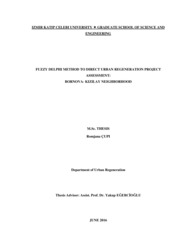Fuzzy delphi method to direct urban renegeration project assessment: Bornova-Kızılay neighborhood
-
Eser Sahibi
Çupı, Romjana
- Tez Danışmanı Yakup EĞERCİOĞLU
-
Tür
Yüksek Lisans
- Yayın Tarihi 2016
-
Yayıncı
İzmir Katip Çelebi Üniversitesi Fen Bilimleri Enstitüsü
- Tek Biçim Adres Http://hdl.handle.net/11469/648
-
Konu Başlıkları
Kentsel dönüşüm
Urban regeneration
Yapı değerlendirme
Building Assessment
Fuzzy Delphi Method (FDM)
Resident satisfaction is an important issue in urban regeneration projects (URP). In the western countries, the resident satisfaction from residential environments continues to be an important topic for researchers and the data found well preserved and integrated into real projects. In Turkey, yet, there is little research on residential satisfaction in many urban regeneration projects implemented. In Turkey, up to the present, research carried out about urban analysis and residential satisfaction needed in any urban regeneration project, is little evident in implemented UR projects.
Izmir is the third biggest city in Turkey that has experienced rapid population growth due to the rural-urban migration. Urban regeneration is a multidimensional and coordinated process that can produce sustainable solutions for urban areas in physical, socio-cultural and economic aspects.
However, problems experienced in issues such as participation, legislation, organization and not preserving characteristic features of the region in implementation of the projects, impede the goal achievement of URP. As a result, while not meeting the needs of users, problems such as unqualified structures and spaces together with unfair profits, rental fees, social exclusion and lawlessness arise. Thus, according to the urban life quality, in order to achieve a holistic and successful urban regeneration is required, at the end of the UR process, to produce quality buildings and spaces that meet the needs of residents.
Bornova-Kızılay neighborhood is an area with low quality housing structures that has received the attention of municipality as a zone in need for urban regeneration. In this study, quality of life in Kızılay neighborhood is evaluated from the resident’s point of view. A survey was conducted to collect data both at the building and neighborhood scale. Factors studied in building scale size are: (i) construction conditions and age of the building, (ii) architectural features, (iii) modifications done and the wish for repairs/renovation, (iv) physical condition and energy efficiency, (v) property condition. The factors for the neighborhood scale are; (i) social structure, (ii) amenities, (iii) economic structure, (vi) architectural features, (v) infrastructure status, (vi) public transportation and road quality, (vii) health and safety. The main purpose of this study is to show how, by evaluating building and neighborhood development criteria concerning the occupant’s prospects, an effective process can be utilized for the Urban Regeneration Projects. It is crucial for the success of the UR projects to see and analyze each site from the point of view of its occupants. How they use and feel the neighborhood structures and environment can give necessary insights into how a successful urban regeneration project can proceed. What the residents of the selected site want to have in their neighborhood, what they want to protect, what they do not want, and what they are in need of, are used as core indicators for this study. The data gathered from questionnaires completed by the residents of Bornova-Kızılay neighborhood, selected as the area of study, are evaluated based on the Fuzzy Delphi Method (FDM). To ensure understanding of the
xx
users’ need for district revitalization and regeneration (DRAR), in neighborhood and building scale, the questions and indicators were formulated by a group of 33 (thirty three) professionals.
Through this study done in Bornova-Kızılay neighborhood; intended research is conducted and recommendations are made on how to achieve public participation and realistic needs assessment in urban regeneration projects.
-
Koleksiyonlar
ENSTİTÜLER
FEN BİLİMLERİ ENSTİTÜSÜ

 Tam Metin
Tam Metin

